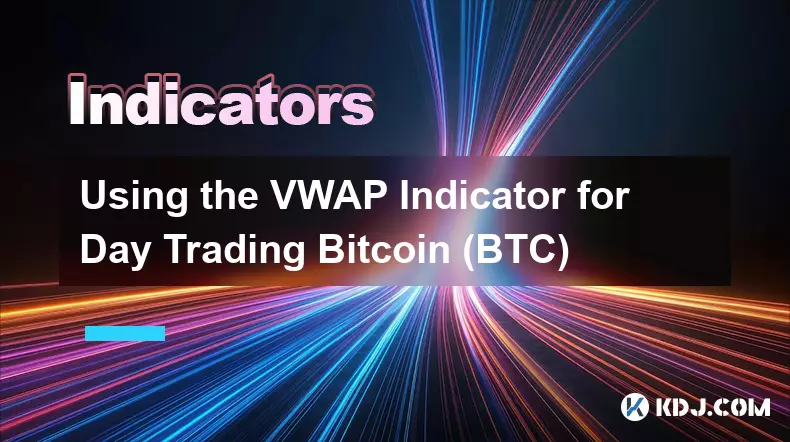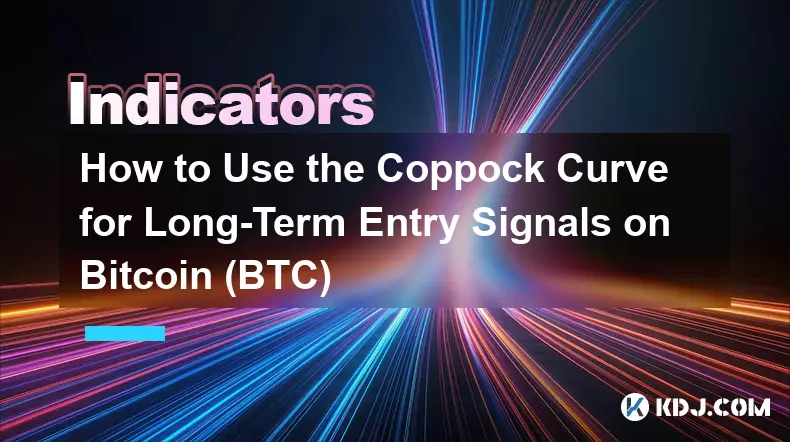-
 bitcoin
bitcoin $107015.826941 USD
-2.18% -
 ethereum
ethereum $3637.352324 USD
-5.18% -
 tether
tether $0.999831 USD
-0.02% -
 xrp
xrp $2.338078 USD
-6.23% -
 bnb
bnb $998.272150 USD
-6.97% -
 solana
solana $167.598257 USD
-10.12% -
 usd-coin
usd-coin $0.999863 USD
0.01% -
 tron
tron $0.282573 USD
-5.09% -
 dogecoin
dogecoin $0.169891 USD
-7.39% -
 cardano
cardano $0.557554 USD
-7.03% -
 hyperliquid
hyperliquid $39.914802 USD
-5.85% -
 chainlink
chainlink $15.414549 USD
-9.97% -
 bitcoin-cash
bitcoin-cash $510.361911 USD
-4.26% -
 ethena-usde
ethena-usde $0.999194 USD
-0.03% -
 stellar
stellar $0.282092 USD
-6.07%
Using the VWAP Indicator for Day Trading Bitcoin (BTC)
VWAP helps Bitcoin traders gauge market sentiment by combining price and volume, serving as a dynamic benchmark for entries, exits, and trend confirmation.
Oct 27, 2025 at 09:15 pm

Understanding the VWAP Indicator in Bitcoin Trading
1. The Volume Weighted Average Price (VWAP) is a crucial analytical tool used by day traders to assess the average price of Bitcoin based on both volume and price over a specified time period. Unlike simple moving averages, VWAP accounts for how much BTC was traded at different price levels, offering deeper insight into market sentiment.
2. Traders use VWAP as a benchmark to determine whether Bitcoin is being bought or sold aggressively. When the current price of BTC trades above the VWAP line, it often indicates bullish momentum driven by strong buying pressure. Conversely, prices below VWAP may signal bearish control and potential distribution phases.
3. Institutional traders closely monitor VWAP because it helps them execute large orders without significantly impacting the market. By aligning their trades with VWAP, they aim to achieve better average entry and exit points, minimizing slippage and improving execution efficiency.
4. For retail day traders, VWAP acts as both a trend confirmation tool and a dynamic support/resistance level. It adjusts throughout the trading session based on real-time volume, making it especially useful during high-volatility periods common in the cryptocurrency markets.
5. Because Bitcoin operates 24/7, traditional VWAP calculations that reset daily can still be effective when applied to specific trading windows. Many traders customize the reset point to match their strategy, such as using a 12-hour or rolling session instead of a standard 24-hour cycle.
How VWAP Enhances Entry and Exit Decisions
1. A common strategy involves entering long positions when Bitcoin’s price crosses above the VWAP with increasing volume, suggesting accumulation. This breakout is more reliable when confirmed by candlestick patterns like bullish engulfing or hammer formations near the VWAP line.
2. Short entries are often considered when BTC fails to sustain moves above VWAP and begins trending below it, particularly after a rejection from a key resistance zone. Traders watch for volume spikes on the downside to validate downward momentum.
3. Using VWAP as a trailing guide allows traders to adjust stop-loss levels dynamically, placing them just below VWAP in uptrends or above it in downtrends. This method protects profits while giving room for normal price fluctuations.
4. Exits can be timed when price reaches extreme deviations from VWAP, especially when combined with overbought or oversold conditions detected via oscillators like RSI or Stochastic. These divergences help prevent holding positions too long during exhaustion moves.
5. Scalpers rely on tight clusters around VWAP to identify micro-trends within larger swings. In ranging markets, they buy near VWAP support and sell near upper Bollinger Bands, assuming mean reversion tendencies hold under low directional bias.
Combining VWAP with Other Technical Tools
1. Pairing VWAP with Bollinger Bands creates a powerful framework for identifying volatility expansions and contractions in Bitcoin’s price action. When BTC touches the lower band and bounces toward VWAP on rising volume, it may indicate a short-term reversal opportunity.
2. Integrating VWAP with time-based filters, such as matching it to peak liquidity hours (e.g., U.S. and European market overlaps), increases signal reliability. High-volume sessions tend to produce stronger trends aligned with VWAP direction.
3. Some traders overlay multiple VWAP lines—such as pre-market VWAP and post-market VWAP—to distinguish between institutional order flow and speculative retail movements. Discrepancies between these lines can reveal hidden strength or weakness.
4. Combining VWAP slope analysis with MACD crossovers adds confluence to trade setups. A positively sloping VWAP alongside a bullish MACD crossover reinforces long-side bias, especially after pullbacks to the average price.
5. Order book data from exchanges can complement VWAP signals by showing imbalances near key VWAP interaction zones. Large bid walls forming as price approaches VWAP from below increase confidence in bounce scenarios.
Frequently Asked Questions
What makes VWAP different from a simple moving average in BTC trading?VWAP incorporates trading volume into its calculation, giving more weight to price levels where significant transactions occurred. This makes it more reflective of true market value compared to a simple moving average, which treats all prices equally regardless of volume.
Can VWAP be used effectively in sideways Bitcoin markets?Yes, in consolidation phases, VWAP often acts as a central pivot point. Traders use it to fade extremes, buying when price dips below VWAP with low momentum and selling when it rises above with diminishing volume, expecting a return to equilibrium.
Is VWAP suitable for longer-term crypto investing?VWAP is primarily designed for intraday analysis and short-term execution strategies. While it can provide context for daily trends, investors focusing on multi-week or monthly horizons typically rely on other indicators such as on-chain metrics or macroeconomic signals.
Do all Bitcoin exchanges display VWAP on their charts?Most major platforms including Binance, Bybit, and Kraken offer VWAP as an optional indicator in their charting tools. However, customization options like session resets or multi-VWAP overlays may require advanced interfaces such as TradingView integration.
Disclaimer:info@kdj.com
The information provided is not trading advice. kdj.com does not assume any responsibility for any investments made based on the information provided in this article. Cryptocurrencies are highly volatile and it is highly recommended that you invest with caution after thorough research!
If you believe that the content used on this website infringes your copyright, please contact us immediately (info@kdj.com) and we will delete it promptly.
- ADA Slowdown, Maxi Doge, and the Meme Coin Mania: What's the Hype?
- 2025-11-04 20:50:12
- Ethereum, Crypto, and the $1 Target: A New Era?
- 2025-11-04 21:00:12
- Zone Nine: Nihilation - A Deep Dive into the Zombie Survival Closed Playtest
- 2025-11-04 21:10:12
- Trust Wallet VIP Program: TWT Powers a New Era of User Loyalty
- 2025-11-04 21:05:01
- Stewards Inc., Token-for-Equity, and the Dolomite PIPE: A New Era for Digital Asset Treasury
- 2025-11-04 21:05:14
- Meme Coins, Degen Alpha, and Market Updates: Riding the Crypto Wave in Style
- 2025-11-04 21:10:02
Related knowledge

Technical analysis for crypto: using RSI and MACD to find trading signals.
Nov 03,2025 at 03:18pm
Decentralized Exchanges Are Reshaping Trading Dynamics1. Decentralized exchanges (DEXs) have gained significant traction by eliminating intermediaries...

The Best Exponential Moving Average (EMA) Settings for Crypto Swing Trading
Oct 25,2025 at 04:55pm
The Best Exponential Moving Average (EMA) Settings for Crypto Swing TradingSwing trading in the cryptocurrency market relies heavily on identifying tr...

How to Use the Coppock Curve for Long-Term Entry Signals on Bitcoin (BTC)
Oct 31,2025 at 03:01pm
Understanding the Coppock Curve in Bitcoin Analysis1. The Coppock Curve is a momentum indicator originally designed for stock market indices but has f...

A Beginner's Guide to Finding Divergence with the MACD on the Solana (SOL) Chart
Oct 26,2025 at 12:36pm
Understanding MACD and Its Role in Solana Trading1. The Moving Average Convergence Divergence (MACD) is a momentum indicator widely used in cryptocurr...

How to Use the Aroon Indicator to Identify New Trends in Cardano (ADA)
Oct 26,2025 at 10:18pm
Understanding the Aroon Indicator in Cryptocurrency Trading1. The Aroon indicator is a technical analysis tool designed to identify whether an asset i...

Trading the Ichimoku Cloud "Kumo Twist" for Ethereum (ETH) Reversals
Oct 27,2025 at 01:54am
Understanding the Ichimoku Cloud and Its Components1. The Ichimoku Cloud, also known as Ichimoku Kinko Hyo, is a comprehensive technical analysis tool...

Technical analysis for crypto: using RSI and MACD to find trading signals.
Nov 03,2025 at 03:18pm
Decentralized Exchanges Are Reshaping Trading Dynamics1. Decentralized exchanges (DEXs) have gained significant traction by eliminating intermediaries...

The Best Exponential Moving Average (EMA) Settings for Crypto Swing Trading
Oct 25,2025 at 04:55pm
The Best Exponential Moving Average (EMA) Settings for Crypto Swing TradingSwing trading in the cryptocurrency market relies heavily on identifying tr...

How to Use the Coppock Curve for Long-Term Entry Signals on Bitcoin (BTC)
Oct 31,2025 at 03:01pm
Understanding the Coppock Curve in Bitcoin Analysis1. The Coppock Curve is a momentum indicator originally designed for stock market indices but has f...

A Beginner's Guide to Finding Divergence with the MACD on the Solana (SOL) Chart
Oct 26,2025 at 12:36pm
Understanding MACD and Its Role in Solana Trading1. The Moving Average Convergence Divergence (MACD) is a momentum indicator widely used in cryptocurr...

How to Use the Aroon Indicator to Identify New Trends in Cardano (ADA)
Oct 26,2025 at 10:18pm
Understanding the Aroon Indicator in Cryptocurrency Trading1. The Aroon indicator is a technical analysis tool designed to identify whether an asset i...

Trading the Ichimoku Cloud "Kumo Twist" for Ethereum (ETH) Reversals
Oct 27,2025 at 01:54am
Understanding the Ichimoku Cloud and Its Components1. The Ichimoku Cloud, also known as Ichimoku Kinko Hyo, is a comprehensive technical analysis tool...
See all articles










































































